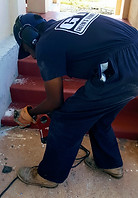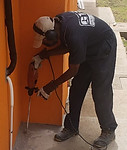
M: 246 844-6680
Est. 2001
Nobody does it better
Over 48 Years of Pest Control Experience

Top Quality Guaranteed
Termite Control in Barbados and the Caribbean: A Proactive Approach
Termites pose a significant threat to structures in Barbados and the Caribbean due to their ability to cause extensive damage. Effective termite control strategies are crucial for protecting homes and businesses from these wood-destroying insects.
Pre-Construction Treatment:
A proactive approach to termite prevention involves implementing pre-construction treatments. This method entails applying specialized termite-resistant materials or treatments to the foundation and surrounding soil before construction commences.
By creating a protective barrier between the building and the soil, pre-construction treatments can significantly reduce the risk of termites entering and damaging the structure.
Post-Construction Treatment:
For existing structures affected by termites, post-construction treatments are employed. These treatments involve applying termite-resistant materials to the foundation and surrounding soil to eliminate existing termite colonies and prevent future infestations.
Professional pest control experts can assess the severity of the infestation and recommend appropriate treatment methods.
Key Considerations:
-
Regular Inspections: To ensure ongoing protection, periodic inspections by qualified professionals are recommended to detect early signs of termite activity.
-
Environmental Factors: The Caribbean's warm, humid climate provides ideal conditions for termite growth and reproduction. Therefore, vigilant termite control measures are crucial in this region.




Drywood Termites: A Closer Look
Drywood termites are a type of termite that infest dry wood, unlike subterranean termites, that require a moisture source. They are known for their ability to cause significant structural damage to wooden structures.
Identifying Drywood Termites
-
Small pin sized holes: Kick holes as they are called are small, round holes that termites create to expel their fecal pellets.
-
Piles of pellets: Look for small piles of termite droppings beneath kick holes or scattered around the infested area.
-
Hollow sound: Tap on the affected wood. If it sounds hollow or dull, it may be infested.
-
Galleries: Carefully probe the wood to check for internal galleries.
Control Measures
While dry-wood termite colonies can develop slowly, it is crucial to address infestations promptly to prevent further damage.
-
Removal of Infested Wood: This is often the most effective method. Remove and dispose of any heavily infested wood to eliminate the termite population and prevent further spread.
-
Insecticidal Wood Preservative: Apply an insecticidal wood preservative to unpainted or surface-sealed timber to protect it from future infestations.
Monitoring and Prevention
-
Regular Inspections: Conduct periodic inspections of your property, especially in areas with wood structures, to monitor for signs of termite activity.
-
Preventative Measures: Reduce moisture levels in your home, repair leaks, and ensure proper ventilation to create a less favorable environment for termites.




Stages of Pre-Construction Termite Treatment
Foundation Footings:
-
Once the footings are dug, cleaned, and ready for concrete, termiticide will be applied along their entire length.
-
Concrete should be poured immediately after this application to protect the chemical from sun exposure or rain.
Floor Slab:
-
After the marl-fill has been brought in and rammed into place until it is ready for casting, termiticide will be applied to the surface until it is fully saturated, as per your instructions.
-
Once the entire surface has been treated, a damp-proof covering should be placed on the slab area before the concrete is poured.
-
The treated slab should not be tampered with or cut for any reason. If the slab needs to be cut for installations, we should be informed by the Contractor in order to take corrective measures.
Post-Construction Treatment:
-
A final treatment will be conducted after backfill is placed, as outlined in the Post-Construction Treatment section.
In conclusion, obtaining professional termite treatment before commencing construction is the most effective way to prevent termites from gaining access. This is particularly important in Barbados, where termites have infested many homes within a year or two of their completion.
Some homeowners allow builders to use over-the-counter sprays, but this is a bad idea and can encourage termites. To truly protect your home for a long time, a professional treatment is the only effective solution.

Post-Construction Termite Treatment in Barbados
Limitations of Post-Construction Treatment
-
Incomplete coverage: Treating 100% of the targeted areas is challenging due to pipes, conduits, and other hidden utilities.
-
Limitations: Post-construction treatment is generally less effective than pre-construction treatment due to these limitations.
Treatment Process
-
Drilling holes: Holes are drilled in perimeter walls, load-bearing partition walls, and external slab areas.
-
Termiticide injection: Non-repellent termiticides like Termidor or Premise 75 are injected into the holes.
-
Sealing holes: Holes are sealed and plastered after treatment.
Termiticide Action
-
Invisible barrier: Termiticides create an invisible barrier that termites cannot detect.
-
Colony destruction: Forager termites exposed to the termiticide take it back to the colony, thus destroying it in the process.
Warranty
-
Five-Year Warranty: Most structures with well-built foundations qualify for a five-year warranty after treatment. This warranty is extended to both pre-treated and post-treated properties.
-
Exceptions: Structures with packed rock or no foundations may not qualify for the full warranty.
Overall, post-construction termite treatment is a valuable tool for addressing existing infestations. While it may not be as effective as pre-construction treatment, it can help eliminate termites and protect structures from future damage.
Termite treatment is a worthwhile investment for any new home construction in Barbados. While it may seem like a small expense compared to the overall cost of building, it can save you significantly on repairs in the long run.
Here's a summary of the benefits of termite treatment:
-
Protection from day one: Termite treatment provides immediate protection against these voracious termites.
-
Peace of mind: Knowing your home is protected from termites can give you peace of mind and reduce stress.
-
Long-term savings: Preventing termite damage can save you thousands of dollars in repairs.
Contact Green's Exterminating & Fencing Inc by following this link https://rb.gy/51oy88 and schedule a Free Inspection or Consultation.




